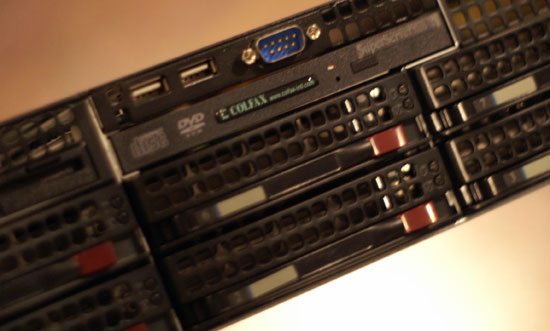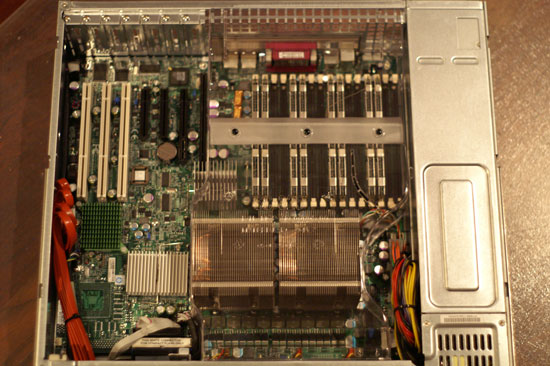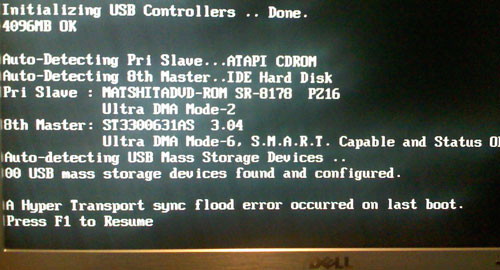AMD Phenom Preview: Barcelona Desktop Benchmarks
by Anand Lal Shimpi on September 10, 2007 12:03 AM EST- Posted in
- CPUs
The Servers
AMD was kind enough to send us two servers, identically configured, from Colfax. The configurations were as follows:
| AMD | Intel | |
| Motherboard | Supermicro H8DMU+ | Supermicro X7DBE+ |
| BIOS Revision | DMU8157v3.ROM | R1.3C |
| CPU | 2 x Opteron 2350 (2.0GHz) | 2 x Xeon 5345 (2.3GHz) |
| Memory | 8GB (8 x 1GB DDR2-667) | 8GB (8 x 1GB FBDIMM-667) |
| Hard Disk | 1 x Seagate Barracuda ES (400GB) | 1 x Seagate Barracuda ES (400GB) |
| Power Supply | 700W Redundant | 700W Redundant |
| OS | Windows Server 2003 SP1, 64-bit | Windows Server 2003 SP1, 64-bit |
These are standard Socket-1207 servers, meaning they don't take advantage of the split power-planes of Barcelona. Newer motherboards (such as the one Johan used in his tests) will support split power-planes, allowing Barcelona to run its North Bridge at a higher clock frequency, thus improving memory performance. Note that our desktop benchmarks were run under Windows Vista Ultimate (32-bit). Update: AMD has confirmed that these motherboards are Socket-1207+ and thus support split power-planes. We apologize for the error.

2U Colfax server

Colfax Intel Server

Colfax AMD Server, one CPU removed
Both systems worked just fine, but we did spend more time with the AMD system (obviously). During our testing we'd occasionally get a Hyper Transport error upon reboot, but it was intermittent and didn't interfere with our results:

Then, at the very end (literally two hours before publication) of our benchmarking, the AMD server stopped POSTing. As of now the system will simply sit there and spin its fans without actually putting anything on the screen. A number of things could have happened, but thankfully the Barcelona system decided to die after we ran all of our tests.
The take away point here is that AMD is working as quickly as possible to push out this Barcelona release. While AMD states to expect availability as early as today, we're concerned about the maturity of these platforms. We got our test systems on Friday, if this were truly a large, widespread launch we would've had hardware long ago. Whereas everyone and their mom already has a sample of Intel's 45nm CPUs, Barcelona continues to be tough to come by and performance hasn't been anywhere near final until now.
Logistics aside, we now have final silicon in hand (and a dead server on our floor), so let's see what we can do.










70 Comments
View All Comments
MadBoris - Monday, September 10, 2007 - link
hmm, especially if it is only @cas5, as mentioned above.It will be interesting to see if it yields anything more than just a few percent, as to scaling, and if benefits compound per socket.
As to one socket and 4 cores I don't really envision it being that much more than a few percent, but then again, I'm not investing any thought or speculation to try and figure out what will be answered when it actually matters and HW is available.
Major point for me is, being able to OC a q6600($280) to 3.2GHz - 3.4GHz on air is going to be real stiff competition for AMD's Phenom, as to my purchasing decisions, which is all I am concerned about mainly.
Also I believe all peoples talk about "true" quad is going to fall a bit flat for the majority of applications/games in real world comparisons with Kentsfield. Because already anyone that is interested to research it can see that the cache/bus penalties in scaling from 2 to 4 cores is basically nonexistent on applications that actually 'fully leverage' all 4 cores. Some apps will benefit, but I expect this to come to light before long and people will see that the penalty of 2 cores in one (Intel Quad), was more speculation, than actual reality, for 'most' consumer applications and games.
I do like AMD's advances but we seriously need more frequency, CPI cannot be overlooked.
duploxxx - Monday, September 10, 2007 - link
if AMD is already able to show multiple phenom systems on 3.0GHZ without dditional cooling (just boxed heatpipe cooler) then i wouldn't be too worried about oc performance of k10ilkhan - Monday, September 10, 2007 - link
15% over K8 is not going to be enough if it launches at (or at least doesn't overclock easily to) 3.2Ghz. At the 2.5 indicated here, yorkfield@3.2+ is going to eat agena for lunch, while being more profitable for intel than agena can hope to be for AMD.Pity.
JackPack - Monday, September 10, 2007 - link
Based on these numbers, consumers are likely going to stick with Intel quads.Clock for clock, Kentsfield was often >30% faster than Quad FX. Barcelona being 15% faster than K8 is reasonable but it's clearly not going to touch Penryn/Yorkfield.
duploxxx - Monday, September 10, 2007 - link
Alltough it is nice to see what anand tried to put here on electronic paper. I can't be compared to the real phenom in a few months.If you want to know why, check Anand's memory review of a year a go and check how well k8 and also k10 is scaling with better/faster memory.
in a barcelona rig you have reg 667@cas5.
so people who are already making conclusions on these benches, one reply: too early.
JackPack - Monday, September 10, 2007 - link
This isn't K8 though. The L3 in Barcelona is going to make it less sensitive to memory bandwidth and latency.Regs - Monday, September 10, 2007 - link
Memory hits and misses (latency) have nothing to do with the L3. The L3 is there as a buffer for the information being proportion to the 4 cores.JackPack - Monday, September 10, 2007 - link
Look up the term "memory hierarchy."Regs - Tuesday, September 11, 2007 - link
what do you think pulls the data into the L3? God?JackPack - Tuesday, September 11, 2007 - link
It's called prefetching. The data is in the L3 before the CPU needs it, reducing memory traffic and latency.Not only that, but Barcelona has a L3 latency of 20ns. To get data from the main memory, it has to go through all levels of cache. When you look at the cumulative latency of the memory hierarchy, the one or two cycle penalty of RDDR2 is trivial.